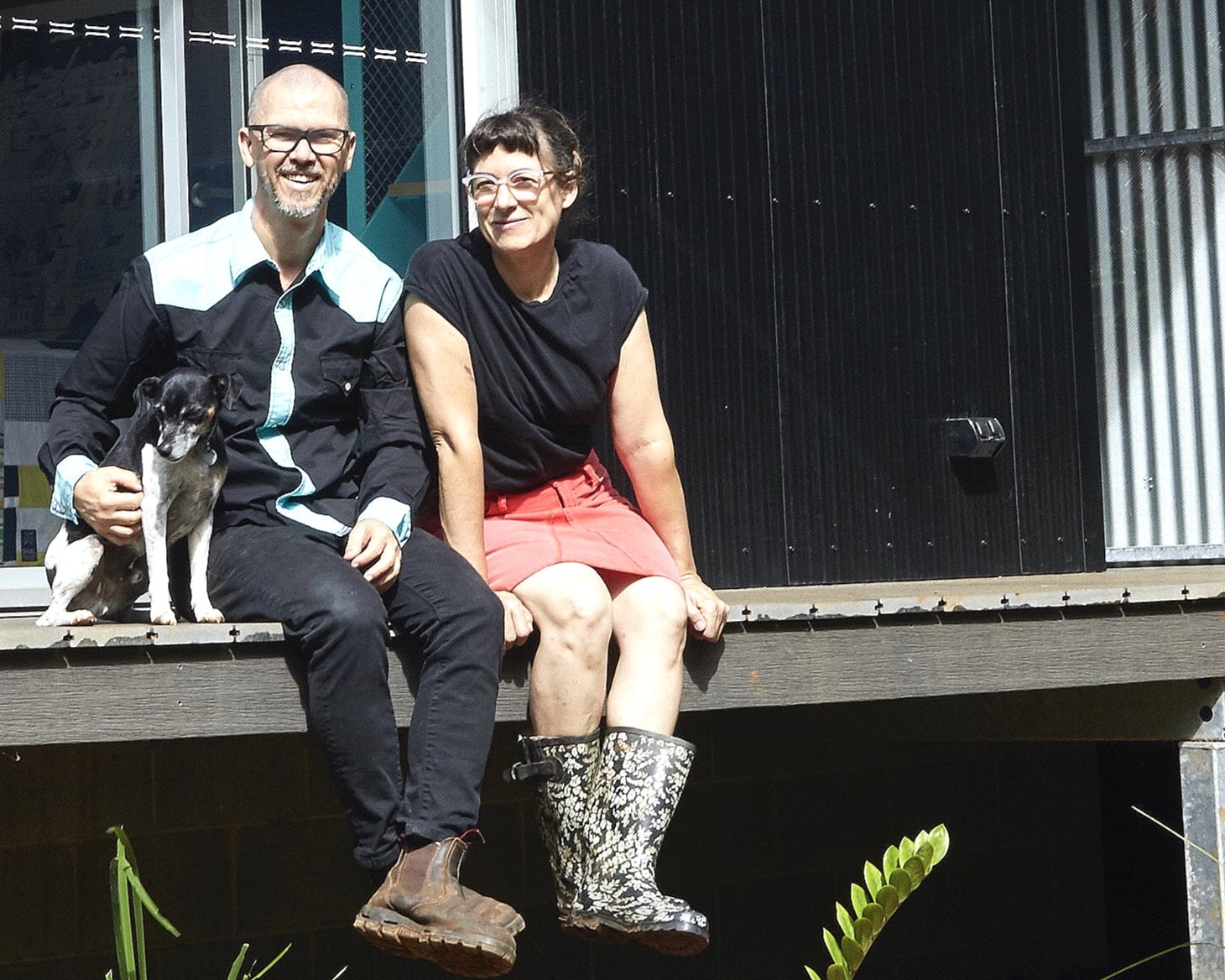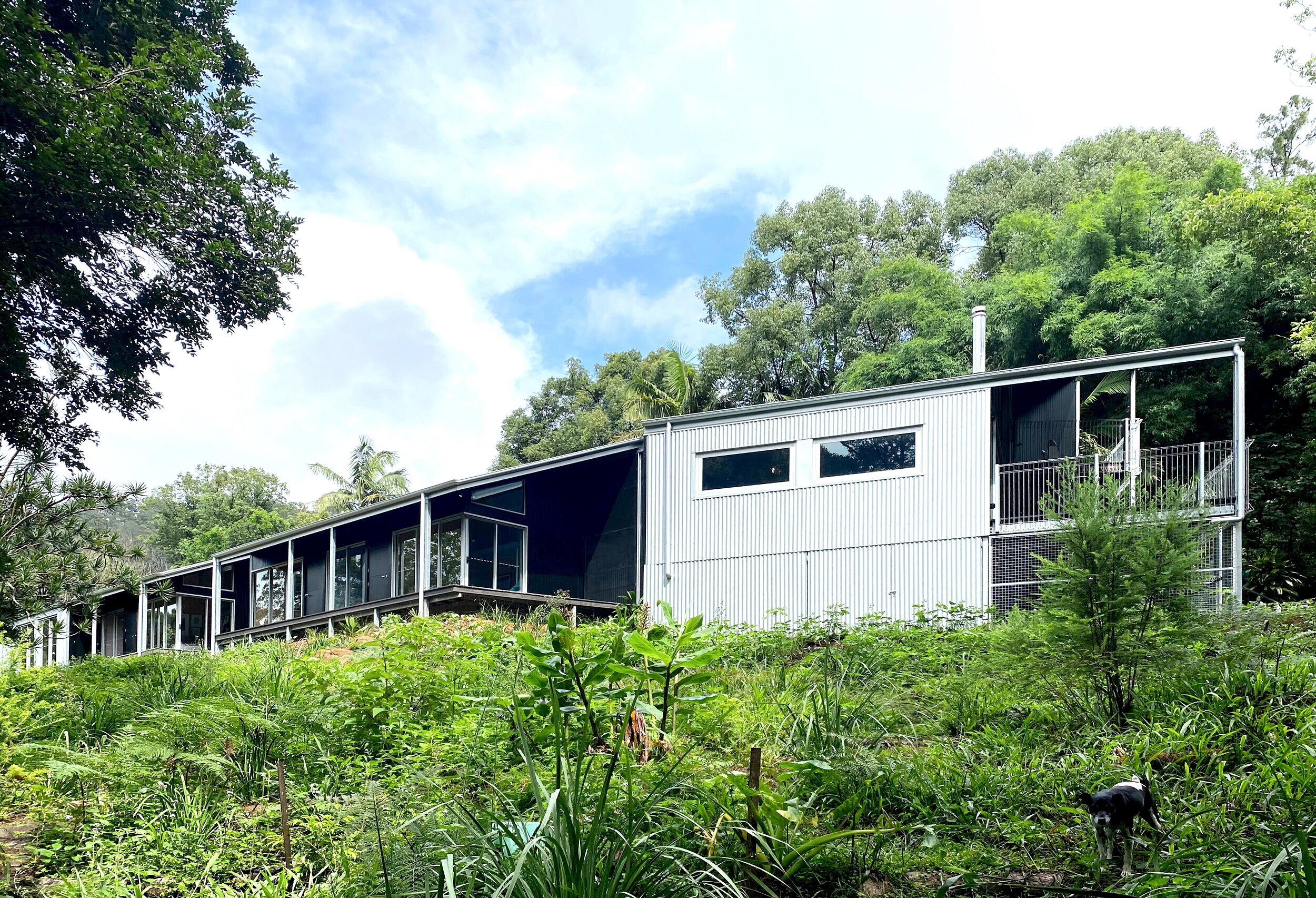Sandra Kaji-O’Grady & John de Manincor
The Two of us
Interview by Peter Salhani | photography by anna hutchcroft, Jonathan roberts
For architects / educators Sandra Kaji-O’Grady & John de Manincor, the rise of Trump, Covid and leaving academia were the catalysts for a mid-life tree change that kickstarted their first joint project and a new practice, Possible Studio, as well as moving into a communal home.
what do you do and how did you become this?
Sandra: For 25 years I was an academic, architectural educator, researcher and manager. Since leaving academia, I’ve been trying out new self-definitions. I’ve had a secret art practice for decades and during COVID it consumed me. Now I’m spending more time making art, and being involved directly in the design of buildings, which has made me very happy.
John: I am a dad, a friend, occasional chainsaw wielder and an architect. I’d always wanted to be an architect but did not do so well at high school. After a year on exchange in Japan I started an arts degree in Newcastle with a double major in Japanese and law. For some reason I met a lot of architecture students. It looked like they were having fun in a perverse way. I pestered the Barry Maitland (former Head of School) for an interview and talked my way in. Barry got out of architecture and is now a successful crime novelist!
Porous House. Photo: Jonathan Roberts
what were your childhood landscapes like?
Sandra: I grew up in the suburbs of Perth. It was hot and dry, with moments of great joy in the landscape, but also, much tedium. I couldn't wait to leave Perth and did so immediately after high school via a Rotary exchange student scholarship to Vancouver. John and I share the experiences of suburban childhoods and being exchange students. He went to Japan.
John: I grew up in the western suburbs of Sydney. Dad was a DIY maker, mum was rather crafty. I recall exploring a major extension of our house ‘designed’ by dad (a computer engineer). He had me picking up nails and offcuts left by the builders. Waste on building sites still drives me nuts! I never loved suburbia, I felt isolated. I found my tribe at university. Many are still friends today. Maybe one of the reasons I’ve always taught is that I find (found) campus life stimulating.
Porous House by Possible Studio. Photo: Possible Studio
“People ask: what’s it like to share your home with others?”
Porous House. Photo: Anna Hutchcroft
where do you live and why?
John: We live in what was to be a shared holiday house with another family and our tween-age son. It’s in an a rainforest valley in the Byron Bay hinterland of NSW – Bundjalung Country. We moved here for our mental health, and that rubs off onto the family. The house was designed with communal spaces and lots of nooks and crannies for everyone to have their own space. It’s called Porous House because families and friends are always in and out of here – it’s a micro-community. People ask “what’s it like to share your home with others?” The answer is: “as easy as you want it to be”. Working with the other couple on regenerating the forest, building a studio and doing much of the house fit-out together has built a life-long friendship.
Sandra: It’s a small 5-acre parcel of forested land. When Trump was elected, we sold our Sydney home and bought this land with friends, and have together built a cabin and a house, plus all the furniture and furnishings. It’s a social, ecological and architectural experiment in living with others, consuming less and learning new DIY skills.
“It’s a social, ecological & architectural experiment in living with others, consuming less and learning new DIY skills.”
Porous House. Photo: Anna Hutchcroft
game-changer moments?
John: Meeting Adam Russell at some architecture event. We formed a practice (DRAW, de Manincor Russell Architecture Workshop). Adam’s a great architect and brilliant human. He introduced me to Sandra. Another big change came when Sandra became Dean of Architecture at The University of Qld (UQ), where I also taught part-time. Perhaps COVID has been the biggest game-changer of all. We took ‘voluntary separation’ packages from the university, which enabled us to rethink our future, build this home and launch our practice (Possible Studio).
Sandra: I had enrolled to study medicine before I went on a student exchange, but my ‘host’ parents reckoned I’d be a terrible doctor. So I came back, enrolled in arts and then in architecture after a student friend took me to see their design studio. In my adult life, the big game changer came when I reported the Dean of the Faculty of Architecture where I taught, for compromising the student enrolment process. That didn’t go down well! I eventually left after I was offered a position in Queensland. The move interstate was very disruptive for John and our children, but has ultimately led to our current life and practice.
The Great Hall at UTS designed by DRAW. Photo: Brett Boardman
YOUR collaboration?
John: Sandra and I had never worked on a design project together before this house. We’ve done curatorial projects together: an architecture conference and a bid for Australia’s architecture exhibition at the Venice Biennale. Closer to home, the Porous House is an ongoing collaboration between all of us who live here. There’s a lot of forest yet to rehabilitate.
Sandra: With Porous House John and I argued intensely. It was difficult, but a great result at the end. Having worked through our differences, we now collaborate more smoothly; both acknowledging what the other contributes.
Sandra’s Rainforest Studio where a lifelong ‘secret art practice’ is now given free rein. Photo: Possible Studio
“I’ve had a secret art practice for decades.”
Strengths & weaknesses: yours & theirs?
Sandra: I have stamina. What I also bring to the practice is strong eye for colour, texture, and pattern. John is much stronger strategically and with technical construction and documentation. That sounds very gendered, but we’ve got good complementary skillsets. It was incredibly broad minded of him to take me on as a practice partner: who else would take a retired academic?! A weakness of mine is intense shyness. I have a very low social libido. John’s more of an extrovert, he ‘gets’ the social thing – another of his strengths.
John: One of my strengths is an unhealthy knowledge of song lyrics from the 80s and 90s. Seriously though, I think my extroverted nature is a strength, that and persistence. Sandra’s an exceptional thinker and writer, with an amazing eye for colour. But her key strength is her efficiency, and she can multi-task like nobody! She’s also very driven, I love watching her disappear into her art. Her weakness? Computers and IT. She’s not a luddite but… My weakness? I can be very bloody minded at times!
Swimming hole on the Porous House property. Photo: Possible Studio
“I have a very low social libido. John’s more of an extrovert.”
Possible Studio’s master plan for an On Land Learning Centre at the Living School, Lismore NSW, includes repurposing an old tugboat. Photo: Possible Studio
your goals in practice?
Sandra: We conceived the practice with quite a broad remit. Making buildings for communities and people will be part of it. We also want the practice to extend into creating events for Lismore, our closest town. We’re really keen to be part of its renaissance. So, not just buildings, but ideas and friendships. It’s really important in the regions.
“not just buildings, but ideas and friendships. It’s really important in the regions.”
John: Now the house is ‘finished’ we’ll start knocking on doors, registering for government panels etc. I’m interested in community and public projects. The Northern Rivers regions are experiencing huge growth and there’s pressure on housing, so exploring alternative models to meet that need is of interest to me. We’re also doing some pro-bono work for an Aboriginal Land Council in the Hunter Valley, drawing on work I did through UQ in Central Queensland. I hope the growth here will lead to investment in public infrastructure.
Concept for Turraburra Cultural Keeping and Knowledge Centre for Yumbangka Aboriginal Cultural Heritage & Tourism Development Aboriginal Corporation (YACHATDAC), Iningai Nation, Central West Queensland. Designed by John with YACHATDAC as a consultancy at UQ. Render: Ayman Waddy
how do you measure / celebrate success?
Sandra: I never saw my life in terms of success and failure, I just don’t operate in that mode. They’re all just experiences you learn from. What might seem like a success today, could in six months turn out not to be.
John: In practice, there are many and varied ways. A former employer once told me that in practice you should ‘have fun, do good work and make a buck’. I find designing buildings and other things fun! Good work? That can mean happy clients, ongoing work with clients who are interested in your ideas and ideals. Awards and publication can make you feel good. More importantly, success is leaving a place in better shape than you found it. Deep down, you should be the judge of that yourself.
John in Porous House, colour blocking by Sandra. Photo: Anna Hutchcroft
“in practice you should have fun, do good work and make a buck.”
Porous House. Photo: Anna Hutchcroft
HOW DO YOU push through difficulties/failure?
Sandra: With stubbornness.
John: I wear my heart on my sleeve, I get grumpy when I fail. If I am facing a design problem or practice issue I work harder. Or stop and take stock. Sandra is far more level, she brings me back to what’s important – putting design, finance, everything into a perspective of family, physical and mental health.
Colour blocking at Porous House. Photo: Anna Hutchcroft
your relationship to risk?
Sandra: I’m really comfortable with financial and professional risks – I’ve changed cities and jobs many times. But I’m really uncomfortable with physical risks – I’m never going to skydive. Even jumping off a rock into our creek makes me nervous.
John: I was risk adverse when I was younger. Sandra has made me a lot more confident about taking risks. Moving here was initially her idea. We rely on each other’s support for big changes like this.
Keeping weeds at bay to promote rainforest regrowth. Photo: Possible Studio
your toughest lesson/challenges?
Sandra: The aftermath of being a whistle blower at university was a tough lesson. It revealed the limits of my power and influence, and robbed me of professional confidence. I had to rebuild that by focusing on my strengths – I knew I was still a good researcher and a good educator. Receiving an Australian Research Council grant (with a close colleague) helped validate that.
John: As I get older, I feel I can be more honest about mistakes and learning from them. We’ve just had a few awards juries through our house. They’ve asked ‘what would you change,’ and I feel comfortable telling them.
Upstairs balcony at Porous House. Photo: Possible Studio
WHERE TO next?
Sandra: Just making the practice and our shared household work — it’s like we’re getting to do our 30s all over again! I’m working towards an exhibition of my art in the next year, and some of my work was just published in Paradiso magazine. And forest regeneration is a big part of what I want to do. There’s a really good regeneration community here, and we're getting great advice.
John: Personally, I need to stay fit and healthy. Wielding a chainsaw is harder work than you’d think. Professionally, I’d like to see us working with clients who care about the environment and design. We’re not aiming to be a large practice, enough good work to sustain us intellectually, and enough fee-paying work to pay our bills and grow a small passionate team. As much as necessary, as little as possible.
possiblestudio.com.au

























